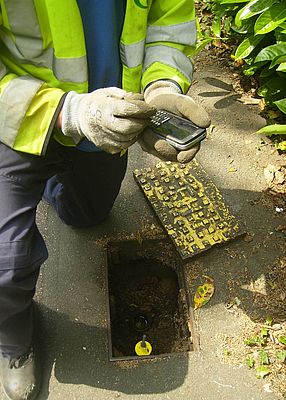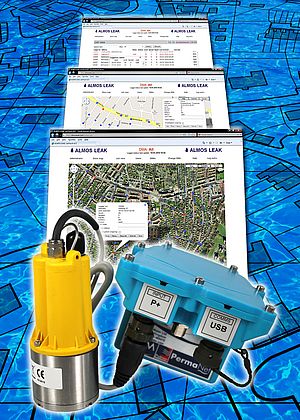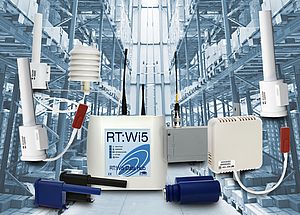Veolia Water, a major water and wastewater management company, has been making use of recent developments in water leak detection technology to effectively manage water networks at an increased efficiency and lower cost. Permalog+ noise loggers have been employed by the company in a ‘lift and shift’ method to quickly, easily and accurately find and repair leaks. Permalog+ noise loggers are small devices deployed at points around the water network, where they monitor the noise levels on the pipes themselves. Changes and distinctive patterns in sound indicate the presence of leaks, often including ones that would otherwise go completely undetected. Mounted directly onto the pipes by a strong magnet, and battery-powered, the Permalog+ units can continuously monitor the section of piping around them for tell-tale signs of a leak. Once found, various telemetry and communication methods are available to alert leak detection operatives either immediately or at a specified time.In a typical usage scenario, the data will either be collected or sent back to a central database, where each logger’s location is displayed on a map with either a green flag for ‘all clear’ or a red flag to indicate a leak. Each logger’s serial number, noise level and noise spread (the leak ‘signature’) is displayed alongside them on the map. Veolia Water has 9 Noise Logger Technicians to carry out ‘lift and shift’ operations, with an average of over 80 individual Permalog+ units deployed and retrieved by each technician every day. The ‘lift and shift’ temporary installation method allows the use of a smaller number of units to cover a large area, effectively ‘auditing’ the network for leaks. As an alternative to a permanent installation, where the loggers would sit waiting and monitoring for new leaks in order to address them immediately, ‘lift and shift’ deployment actively searches for leaks throughout the network in a ‘sweeping’ pattern. Leakage Teams will deploy loggers throughout the next targeted area (typically divided by District Metered Area), where they will remain overnight. The following day, the loggers are collected by the team, with a centralised record being made of where there are leaks and where the system is clear. These loggers can then be deployed to a new area, and so a rolling, sweeping search for leaks quickly progresses throughout the network. In contrast to a ‘permanent’ deployment pattern, Permalog+s for use in a ‘lift and shift’ operation will be either pre-programmed at the factory or by the user with specially designed software to only transmit their recorded data when an operative swipes them with a magnet. There is no radio interference from other loggers nearby (stored in the car, for example), and the data is kept both secure and easily compartmentalised. This is obviously useful when the same loggers will eventually be deployed in many different locations – the fundamental point of the ‘lift and shift’ method. The Permalog+ units and system incorporate several recent technological innovations by Halma Water Management to make them more efficient and easier to use than ever before. The loggers can be pre-programmed, and can automatically record each deployed unit’s serial number and location by GPS tracking. This means that deployment is very quick, and there is no longer a danger of misplacing loggers – or the maps of where they are – which of course means that retrieval is easy too. The Permalog+ version can also utilise the extended logging functionality of Aqualog. This records noise levels at set intervals over a longer time period of up to 29 days. This allows easy trending analysis and graphical representation of the data, providing for more detailed leak analysis and definite confirmation. User-configured or preset alarm threshold settings can be applied for different pipe types and diameters. Veolia Water has had excellent results from this operation, finding leaks with great speed and ease, leading to reduced costs from resources. The new GPS mapping technology tracks and makes visible the effort being applied by the one-man teams, and has resulted in a higher deployment rate than previously seen. It also gave the company an audit trail of loggers, ensuring accountability and precise location tracking. With over 80 loggers per technician per day being deployed and collected, the speed of the activity means that detection time can be reduced when compared to other, more traditional leak-finding technologies and methods. A recent Veolia project that involved targeting 15 DMAs, covering some 28,000 properties, took only 32 days to sweep, and 96 leaks were detected. Because time lost is water lost, the speed of the search and therefore the swiftness of the response is key to minimising waste and reducing Non-Revenue Water levels. Certainly, given the right application, noise loggers in the ‘Lift and Shift’ mode provide an excellent return on the investments of both time and funds. The fact that the Permalog+ system is very accurate in terms of both location and detection, as well as sensitive enough to find even ‘hidden’ leaks, makes it a powerful and effective tool in the ever more important fight against water loss.
Water leak detection technology
reduces water loss and costs
- by Halma Water Management
- June 10, 2010
- 1396 views




















